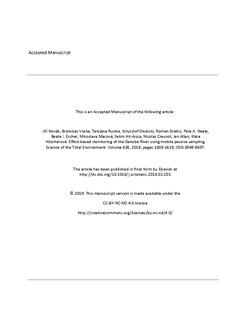| dc.contributor.author | Novak, Jiri | |
| dc.contributor.author | Vrana, Branislav | |
| dc.contributor.author | Rusina, Tatsiana | |
| dc.contributor.author | Okonski, Krzysztof | |
| dc.contributor.author | Grabic, Roman | |
| dc.contributor.author | Neale, Peta A. | |
| dc.contributor.author | Escher, Beate I | |
| dc.contributor.author | Macova, Miroslava | |
| dc.contributor.author | Ait-Aissa, Selim | |
| dc.contributor.author | Creusot, Nicolas | |
| dc.contributor.author | Allan, Ian | |
| dc.contributor.author | Hilscherova, Klara | |
| dc.date.accessioned | 2019-11-20T07:39:51Z | |
| dc.date.available | 2019-11-20T07:39:51Z | |
| dc.date.created | 2019-02-06T17:28:47Z | |
| dc.date.issued | 2018 | |
| dc.identifier.citation | Science of the Total Environment. 2018, 636, 1608-1619. | nb_NO |
| dc.identifier.issn | 0048-9697 | |
| dc.identifier.uri | http://hdl.handle.net/11250/2629373 | |
| dc.description | Embargo until 10 March 2020 | nb_NO |
| dc.description.abstract | Many aquatic pollutants can be present at low concentrations, but their mixtures can still affect health or behavior of exposed organisms. In this study, toxicological and chemical analyses were combined for spatial contamination profiling using an innovative passive sampling approach. A novel Dynamic Passive Sampler (DPS) was employed as a mobile sampler from a ship cruising along 2130 km of the Danube river during the Joint Danube Survey 3 (JDS3). The sampling was performed in eight subsequent river stretches with two types of complementary passive samplers: silicone rubber sheets (SR) used for non-polar chemicals and SDB-RPS Empore™ disks (ED) for more hydrophilic compounds. Besides extensive chemical analyses, the bioactivity of samples was characterized by a battery of reporter gene bioassays. Cross-calibration of the employed passive samplers enabled robust estimation of water concentrations applicable for compounds with a wide range of physicochemical properties. DPS was suitable for sampling of water contaminants even at pg L−1 levels, with 209 of 267 analyzed compounds detected in the samples. Biological effects were detected in both ED and SR extracts across all river stretches by bioassays focused on xenobiotic metabolism mediated by the aryl hydrocarbon and pregnane X receptors, endocrine disruptive potential mediated by estrogen and androgen receptors and the oxidative stress response. The bioassay responses expressed as bioanalytical equivalent concentrations (BEQbio) were comparable with data obtained from large volume active sampling. The extracts of the ED samplers were more biologically active than extracts of SR samplers. Except of estrogenicity, where the analyzed chemicals explained on average 62% of the effects in ED samples, the detected chemicals explained <8% of BEQbio values. The study shows the utility of the combination of the innovative passive sampling approach with effect-based tools for efficient and fast monitoring even in water bodies with relatively low levels of contamination. | nb_NO |
| dc.language.iso | eng | nb_NO |
| dc.publisher | Elsevier | nb_NO |
| dc.rights | Attribution-NonCommercial-NoDerivatives 4.0 Internasjonal | * |
| dc.rights.uri | http://creativecommons.org/licenses/by-nc-nd/4.0/deed.no | * |
| dc.title | Effect-based monitoring of the Danube River using mobile passive sampling | nb_NO |
| dc.type | Journal article | nb_NO |
| dc.type | Peer reviewed | nb_NO |
| dc.description.version | acceptedVersion | nb_NO |
| dc.source.pagenumber | 1608-1619 | nb_NO |
| dc.source.volume | 636 | nb_NO |
| dc.source.journal | Science of the Total Environment | nb_NO |
| dc.identifier.doi | 10.1016/j.scitotenv.2018.02.201 | |
| dc.identifier.cristin | 1674246 | |
| dc.relation.project | EC/FP7/603437 | nb_NO |
| cristin.unitcode | 7464,30,21,0 | |
| cristin.unitname | Miljøkjemi | |
| cristin.ispublished | true | |
| cristin.fulltext | postprint | |
| cristin.qualitycode | 2 | |

